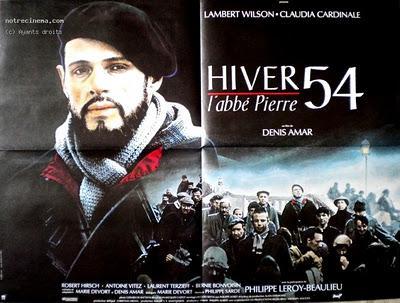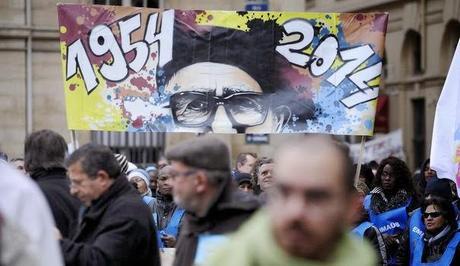
L'Express.fr
I had a fun little story to tell today... It involved the French, the Americans, and swear words.
As I was about to start writing it, I bumped into a photo taken by blogger Eric Tenin. Eric had decided to honor one of the most popular men who ever lived in France. That man was not a monarch; a president; or even a celebrity; quite the opposite in fact. He was a priest, and a sickly man, who doggedly led a lifelong struggle to help others. Seven years after his death, he remains one of my countrymen's favorite public figures. His is an incredible story. A story of courage, determination, controversy and deep humanity. It is the story of l'Abbé Pierre. Sixty years ago, on February 1, 1954, l'Abbé Pierre famously called for solidarity on Radio Luxembourg, as poor, homeless French people were dying in the streets during a particularly harsh winter. Sixty years later, homelessness and a shortage of safe, affordable housing, are still concerns in France, and in many industrialized nations.This week, I have decided to publish again the tribute I wrote in December 2011. I hope you enjoy it.
L'Abbé Pierre: the Reluctant French IconDecember 2011
Today, I would like to tell you the story of a man who embodied Giving. France knows him as "l'Abbé Pierre." His face (the gray hair and beard, the big glasses, the béret,) and silhouette (the long, black cape, the heavy shoes, the cane,) are so familiar to my countrymen that a picture of l'Abbé Pierre hardly needs a caption. During his long life, he remained one of France's most unlikely, and yet most beloved public figures, topping popularity polls year after year, until his death, in January 2007.
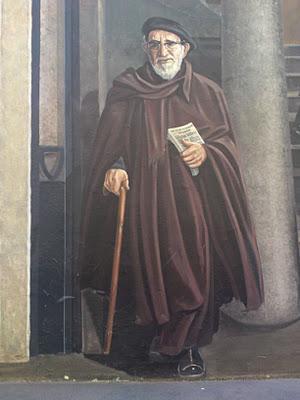
La Fresque des Lyonnais (the famous Lyonnais fresco)
Lyon, France
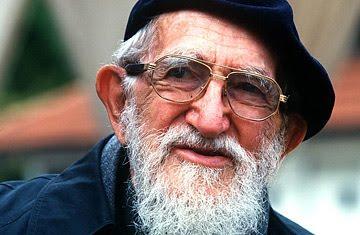
L'Abbé Pierre (1912-2007) was born Henri Marie Joseph Grouès, in Lyon, to a well-heeled bourgeois family of eight children. His father had a strong social conscience and introduced Henri to charity work at a very young age. A devout catholic, Henri was determined to become a missionary. He attended a Jesuit school, and later renounced his inheritance to join a Franciscan monastery. He was ordained priest in 1938. Strict monastic life did not agree with him (he was plagued with health issues,) and he eventually left the monastery.
World War II broke out in 1939. He was mobilized as an N.C.O. (Non Commissioned Officer) but contracted pleurisy while training in Alsace. When France fell in 1940, he became vicar of the Grenoble cathedral. Throughout the war, he would take enormous risks to help others; enabling Jews and other politically persecuted to escape to Switzerland; joining the French Résistance where he operated under several code names including the now-famous "Abbé Pierre;" founding a clandestine newspaper; stealing clothing from warehouses for the poor and the Résistance. He was arrested in 1944 but managed to escape and joined General de Gaulle and the Free French Forces in Algiers. He continued fighting and received top French military honors at the end of the war.
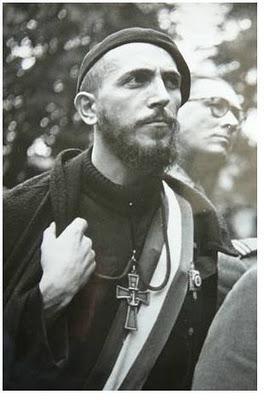
A young Abbé Pierre listens to a speech by General de Gaulle in 1946
The war experience would mark him for life: From then on, he engaged himself to protect fundamental human rights and to fight for the causes he believed in. If legal means were not an option, then civil disobedience was all right too. He also knew how to use his reputation and growing fame, and his connections to politicians to further his cause, lecturing the formidable General de Gaulle, in January 1945 on the need for milk to feed babies.Impatient, stubborn, unruly and outspoken, l'Abbé Pierre was soon to become a major influence in French society, an indefatigable fighter who led a life-long crusade against poverty and homelessness. His tactical weapons: Prayer, provocation, charity work and political action.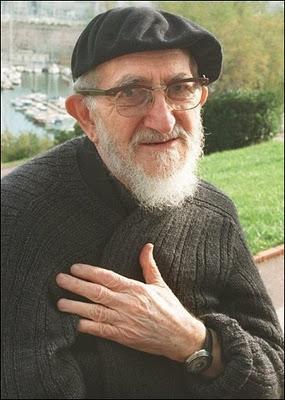
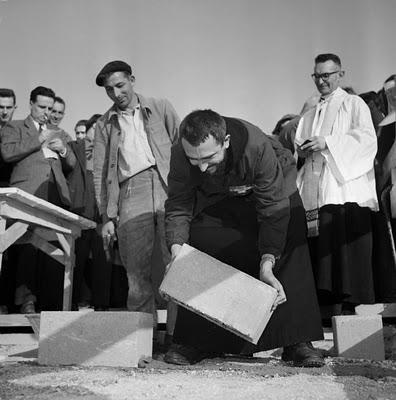
1954: Laying the first stone of a new Emmaus-sponsored shelter
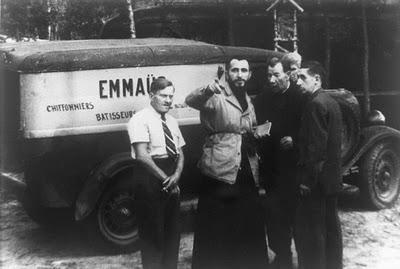
L'Abbé Pierre and the first Emmaus companions
But it is during the exceptionally cold winter of 1954 that L'Abbé Pierre became a living legend. An indignant Abbé issued a radio appeal on behalf of 5 million homeless people after a baby froze to death, and after a woman died on a Paris boulevard clutching her eviction notice in her frozen hand. In his famous speech, he challenged the French to heed their moral duty. The opening words caught everyone's attention: "My friends, come help... A woman froze to death tonight at 3:00am..." The French - no doubt remembering the privations endured during the war - listened, and donations poured in: Money, blankets, clothing, even jewelry and fur coats! My mother-in-law, a young girl at the time, remembers listening to the radio address with her family and walking down to the nearest temporary shelter with clothing and blankets.
Throughout his life, l'Abbé Pierre used the power of the media
to further his cause
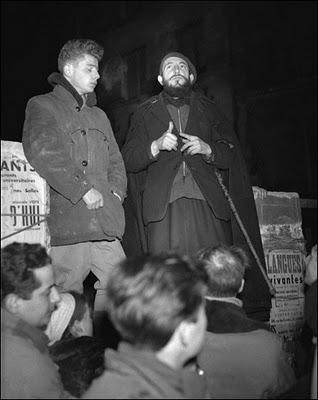
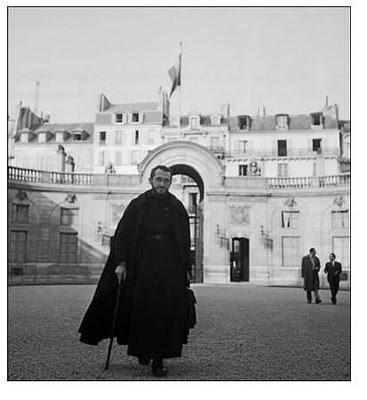
Leaving the Elysée Palace after meeting with the French President (1954)
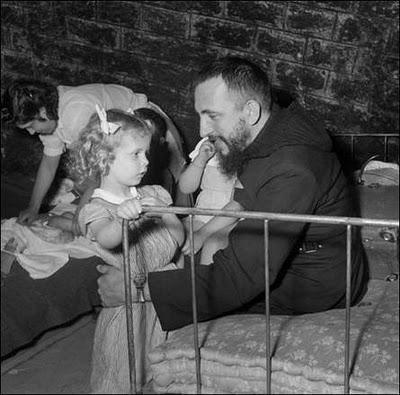
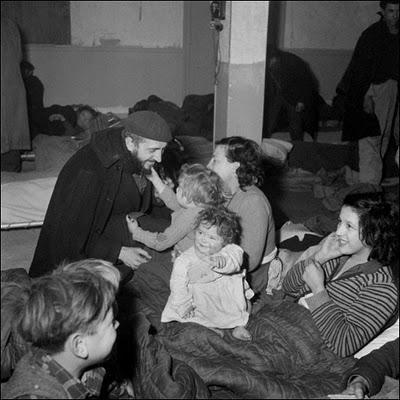
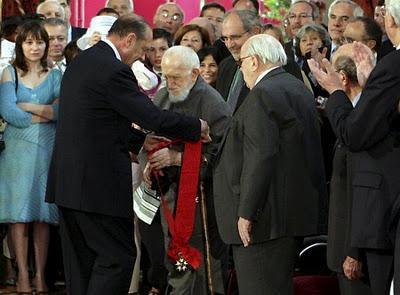
Finally accepting the prestigious Legion of Honor
awarded by President Chirac in 2001
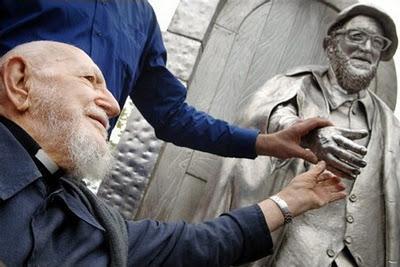
L'Abbé Pierre meets l'Abbé Pierre in 2005
It was finally time for the man President Chirac called: "A great figure, a conscience, an incarnation of goodness," to take his final bow. He died after a long illness, at the age of 94. Statesmen, celebrities, companions of Emmaus and the French public attended his funeral celebrated at Notre-Dame cathedral, on January 26, 2007. L'Abbé's companions were placed at the front of the congregation, according to his last wishes. His iconic béret, cape and cane lay on top of the coffin during the funeral service.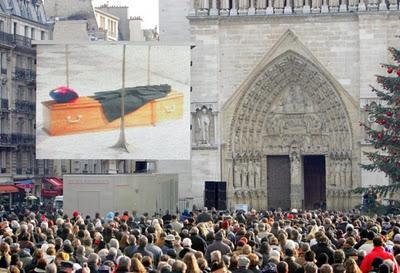
A big funeral for a man who aspired to a simple, monastic life
Henri Grouès - l'Abbé Pierre - rests in a small cemetery in Esteville, a small village north of Rouen, in Normandy. At peace at last, (one would hope,) he is in good company, surrounded by several of his early companions and friends. At his request, his grave is anonymous, but it is easy to find, thanks to all the flowers left by visitors.L'Abbé Pierre (1912-2007): French patriot, human being. Led a life of action and service and knew a thing or two about giving.
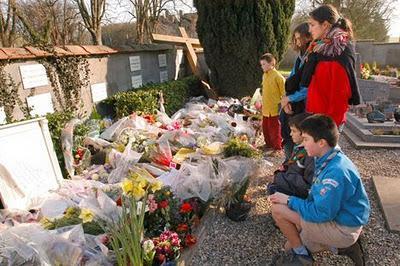
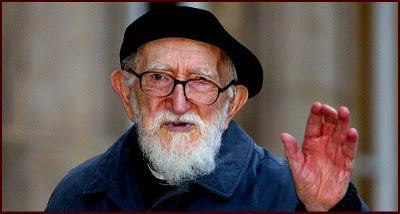
Adieu, l'Abbé. On t'aimait bien.
So long, l'Abbé. We liked you.
Afterword: To learn more about l'Abbé Pierre's inspiring life, watch this excellent documentary (2 video clips, about 18 minutes.) It is utterly frustrating, however, as the second part stops around 1949 when Emmaus, the organization founded by l'Abbe Pierre, was taking off. Still, a great look at his early years and his rise to fame.You may also rent the 1989 movie "Hiver 1954: L'Abbé Pierre" ["Winter 1954: L'Abbé Pierre"] with Lambert Wilson.
